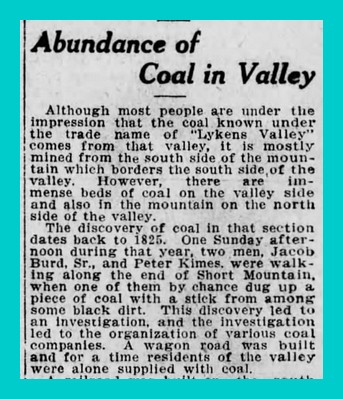The Midland Pennsylvania Railroad, begun in 1910, with plans to connect Millersburg, Dauphin County, Pennsylvania, with Ashland, Schuylkill County, Pennsylvania, turned out to be a colossal failure. In addition to the two terminal points of the railroad, stations were planned in Killinger, Berrysburg, Gratz, Springville, Valley View, Weishample and Mable. Great plans were formulated for the growth of commerce and farming. Much of the hype was presented in a Harrisburg Telegraph article in 1911. That article is transcribed here in several parts, with part six presented today.
This part tells of the prospects for expansion of coal mining in the valley and surrounding areas that will supposedly come about with the construction of the railroad. It must be noted that the defining borders of the Lykens Valley that are noted in the article are not in agreement with the generally assumed borders, which include areas on the south side of Short Mountain, such as Lykens, Wiconisco, and Williamstown.
From the article that appeared in the Harrisburg Telegraph, 16 March 1911:
Abundance of Coal in Valley
by Robert F. Gorman
Although most people are under the impression that the coal known under the trade name of “Lykens Valley” comes from that valley, it is mostly mined from the south side of the mountain which borders the south side of the valley. however, there are immense beds of coal on the valley side and also in the mountain on the north side of the valley.
The discovery of coal in that section dates back to 1825. One Sunday afternoon during that year, two men, Jacob Burd Sr., and Peter Kimes, were walking along the end of Short Mountain, when one of them by chance dug up a piece of coal with a stick from among some balck dirt. This discovery led to an investigation, and the investigation led to the organization of various cola companies. A wagon road was built and for a time residents of the valley were alone supplied with coal.
A railroad was built on the south side of the mountain and because of this all of the coal was mined on the south side as the product could be got to commercial markets with less trouble and expense than if it had been mined on the north side. Nevertheless, there are enormous deposits of un-mined coal on the north side and with the building of a railroad through the Lykens Valley, this coal will be mined.
Hundreds of men who live in the Lykens Valley are miners and many of them must cross the mountains to get to their work. Others enter the mountains through air holes on the north side and through long channels walk to the places where they are employed.
Between the Short Mountain on the south, and the Trevorton Mountain on the north, there are two mountains, the Mahantongo and the Line Mountains. Both of these show indications of having coal in them. Several attempts were made years ago to discover the extent of the veins in these mountains, but owing to the lack of capital and principally the absence of railroad facilities, all efforts were abandoned. The outcroppings on these mountains indicate a good quality of coal and like all formations, the deeper the boring, the better the coal. large areas of these mountain lands are controlled or owned by coal companies, but the most of the land is owned by individuals, who are anxious to have it developed on the royalty basis. This is one of the things which the Lykens Valley Development Company will do. The company will take a stretch of ground, mine it and give the owner a royalty. The owner will have nothing to do but give his consent to the use of the land.
Labor could be secured quite easily because many of the miners who reside in the valley are experts and these men would prefer to work closer to their homes. Many of the men are now compelled to walk from three to five miles to their work.
In the extreme eastern section of the valley there are good coal lands. They show the existence of the same quality of coal as is found and mined in the Schuylkill regions. These lands are adjacent to and a continuation of the veins worked by the various coal companies about Gordon and Ashland. With the establishment of the new railroad all of this land can be secured and profitably worked.
The final part of this series will be entitled “Big Clay Deposits Will Be Developed.”
_________________________________
News article is from Newspapers.com.
Corrections and additional information should be added as comments to this post.
